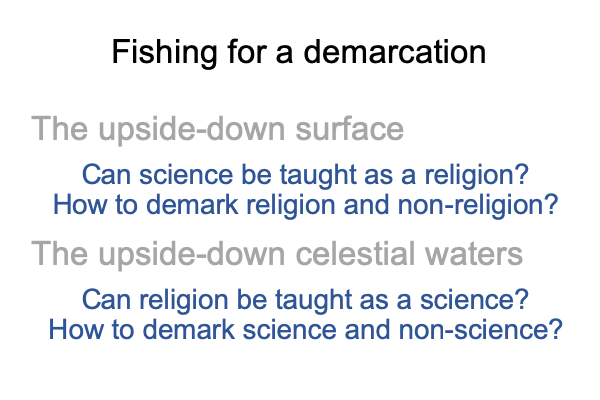0008 Can one differentiate science from non-science?
Why is this question relevant?
The first amendment of the U.S. Constitution states that the federal government shall not establish a religion.
Is that the same as establishing a non-science?
So, the first question twists. Is religion a non-science?
It turns away from an old relevance, where the word “religion” means “a Christian faction”.
It twists towards a new relevance, where “religion” is defined by an underlying meaning, presence and message. This is the topic of the masterwork, How To Define the Word, Religion.
0009 Why is this twist relevant?
What if the U.S. federal government establishes a religion?
What would be the nature of this religion?
Clearly, this religion is not a Christian faction.
Rather, it consists of diverse movements, a thousand points of light, that (F) claim to be “not religious” and (G) demand sovereign power in order to implement their organizational objectives. Since each objective arises from the potential of righteousness, these diverse religions constantly signal their virtues. They are keen on making sure that their organizational objectives get the government funds that they deserve. Righteousness wins power and money.
Does the legal debate that Pennock addresses concern a single point of light, among thousands?
No. Public education is… um… a big fish.
Yes, it’s a gigantic fish with sharp teeth.
0010 So, the question turns full circle.
Can science be taught as a religion?
The world is upside down. The ocean is where the sky should be. The sky is where the sea should be. The demarcation problem rests on the surface of this upside-down ocean. In this world, whales fly in the waters above.
The Story of Creation floats as a little boat that draws the leviathan of public education down from the heights, in a re-enactment of an orientation-challenged Moby Dick. The Captain Ahab of Creation Science wants to kill the leviathan, directly. In doing so, he would bring the celestial waters of the deep state into consciousness. The highly elevated deep state contains a thousand institutions, whose points of light orient Big Government (il)Liberals. Plus, this heavenly sea holds some really big fish.
Because these institutions3aC, both lights and fish, have organizational objectives2aC that emerge from (and situate) the potential of righteousness1aC, they are religions.
They appear to be stars dwelling high in a fish-filled celestial ocean of righteousness.
Ah, the relevant question becomes, “How does one distinguish religion from non-religion?”
0011 Here is how this fully twisted vision appears.

0012 Does this explain why the dismissal of the demarcation problem is premature?
If the world is upside down, then The Creation Science aims to lance a leviathan that dwells deep in the narratives of the heavenly waters of Big Government (il)Liberalism.
